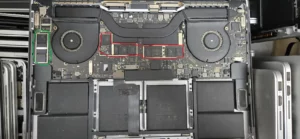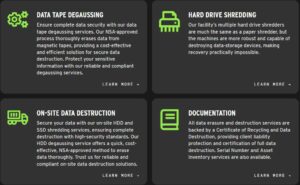It’s easy to overlook the need for data destruction services, especially if you’re someone who tackles things like oil changes or home repairs on your own. After all, the DIY instinct runs deep in American culture; Emerson is in our blood; and a can-do attitude with a dash of self-reliance often carry the day.
But mishandling sensitive data can have serious consequences. Very.
In today’s blog, we’ll explore why professional data destruction services are essential and how taking DIY measures can often backfire and create nightmare scenarios: legally, financially, and reputationally.
We’ll also go into the clear-cut benefits of working with professional data destruction companies like as eAsset Solutions, including compliance, secure handling of sensitive information, proper certification, and environmentally resonsible disposal practices that support the circular economy.
Alright, let’s take a look!
The Risks of DIY Data Destruction

NOTE IN RED: RAM THAT WAS DRILLED. IN GREEN, SSD STILL INTACT.
Recently, a well-meaning customer dropped off several MacBooks, believing they had securely destroyed the data by drilling into the RAM. Unfortunately, they weren’t aware that these particular devices relied on soldered NAND flash storage, not RAM, to house sensitive data. Consequently, the data remained completely intact and accessible.
It’s a common mistake we see too often. Many devices today use tightly integrated storage components that are difficult to identify and even harder to destroy without expert knowledge. Unfortunately, by the time someone realizes they’ve made a mistake, it’s often too late. The device could have already been sold, recycled, or improperly disposed of, leaving a dangerous opening for data breaches. And even if no harm is done, the fear of what could happen is enough to spark audits, breach reports, and sleepless nights over fines and reputational fallout.
The Dangers of Not Knowing Where Data is Stored

DATA DESTRUCTION SERVICES WILL GET IT RIGHT, NOT WRONG
Many DIY attempts at data destruction go wrong for one simple reason: people don’t realize where data is stored. Hard drives in the past were stand-alone components that were easy to remove and destroy. But things are different today. Devices are sleeker, more integrated, more complex, making storage components hard to identify without proper training.
Take modern laptops or smartphones, for instance. Many use soldered NAND flash chips that are permanently fixed to the motherboard. Drilling a RAM chip or snapping a circuit board, as our unfortunate customer did, doesn’t really touch the actual storage: you’ve just destroyed plastic and metal. Apple devices are a prime example where storage is hidden in plain sight.
A False Sense of Security
Now, we get it: DIY data destruction (or anything else for that matter) gives people a sense of control and makes you feel like a beast, but don’t let that fool you. Just because a device looks destroyed doesn’t mean the data inside is gone. In fact, skilled professionals can often recover information from hardware that seems utterly ruined and useless.
For businesses, this illusion of control can be especially costly. If companies expose sensitve data or fail to fully destroy financial details, they face serious risks, including fines, lawsuits, and reputational damage.
Morgan Stanley, for instance, hired a moving company with zero experience in data destruction to handle decommissioned IT equipment. The result? The multinational investment bank potentially exposed the sensitive information of millions of their customers, and agreed to pay $6.5 million to settle claims related to the incident.
The breach also triggered investigations by regulators and raised serious concerns about the company’s oversight and risk management protocols. What seemed like a routine logistics task became a cautionary tale about the cost of cutting corners.
Legal and Compliance Pitfalls

LEGAL AND COMPLIANCE PITFALLS
But failing to destroy sensitive data the proper way doesn’t just risk exposure, it risks breaking the law. Federal and international regulations, including HIPAA, GLBA, FACTA, and GDPR, require secure data destruction and demand that you — in common parlance — have the receipts to prove it. And of course, DIY methods almost always lack the required chain-of-custody documentation, audit trails, and certificates of destruction that are critical for compliance.
How Professional Data Destruction Services Stand Apart
Unlike DIY methods, professional data destruction services offer a systematic, verifiable approach designed for security and compliance. Here’s how:
Proper Identification of Data-Bearing Components
Certified technicians are trained to locate and assess all data-bearing components within a device, even those built into modern devices in non-obvious ways like NAND flash, SSDs, or hybrid drives. Their up-to-date knowledge of device architecture makes sure nothing is missed.
Use of Industry-Approved Methods
By applying industry-approved methods under DoD 5220.00-M and NIST 800-88, professionals guarantee total data destruction. Whether through secure wiping, shredding, or degaussing, these practices leave no room for data recovery.
Verified Results You Can Document
What sets professionals apart is the paper trail. Certified professionals back every destruction with:
1. Certificates of Destruction
2. Serial number verification
3. Asset inventory reports
4. Chain-of-custody records
These records offer peace of mind and help you stay on the right side of the law.
The Cost of Cutting Corners in Data Destruction
Steep Financial Consequences
Violating data privacy regulations like HIPAA, GLBA, OR GDPR can result in bring-you-to-your-knees penalties — up to $50,000 per violation. For larger breaches, the financial fallout can escalate quickly into the multi-millions,affecting industries across numerous sectors.
Reputation at Risk
Security failures don’t stay quiet; word gets around. And a breach becomes public quickly, destroying customer confidence, disrupting partnerships, and inviting negative media attention. The reputational damage can often be more costly and lasting than any fine, as Morgan Stanley unfortunately learned.
Missed Asset Value Recovery
And finally, without professional guidance, destroyed devices may be discarded prematurely, missing eco-friendly opportunities for recirculation or resale. Certified ITAD providers, like eAsset Solutions, assess which assets can be reused safely, helping companies reduce waste, recapture value, and promote the circular economy.
Final Thoughts
Trust the experts. What may look like a simple DIY fix can quickly become a costly error. Between the technical complexity of modern devices, the risk of data exposure, and the consequence of non-compliance, it’s simply not worth the gamble.
Certified data destruction services offer peace of mind through proper methods, thorough documentation, and full regulatory compliance. Whether you’re protecting customer records or proprietary business information, accuracy matters.
Contact eAsset Solutions today to learn how we can help protect your data (and your peace of mind) with certified, professional ITAD and data destruction services.











